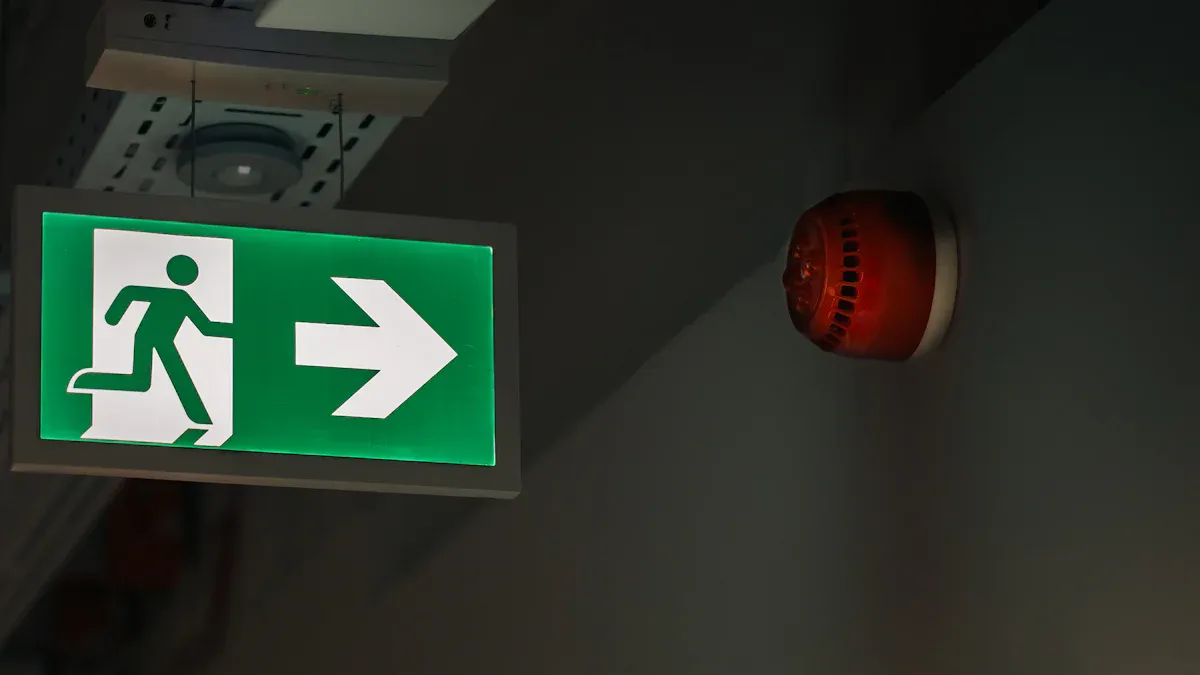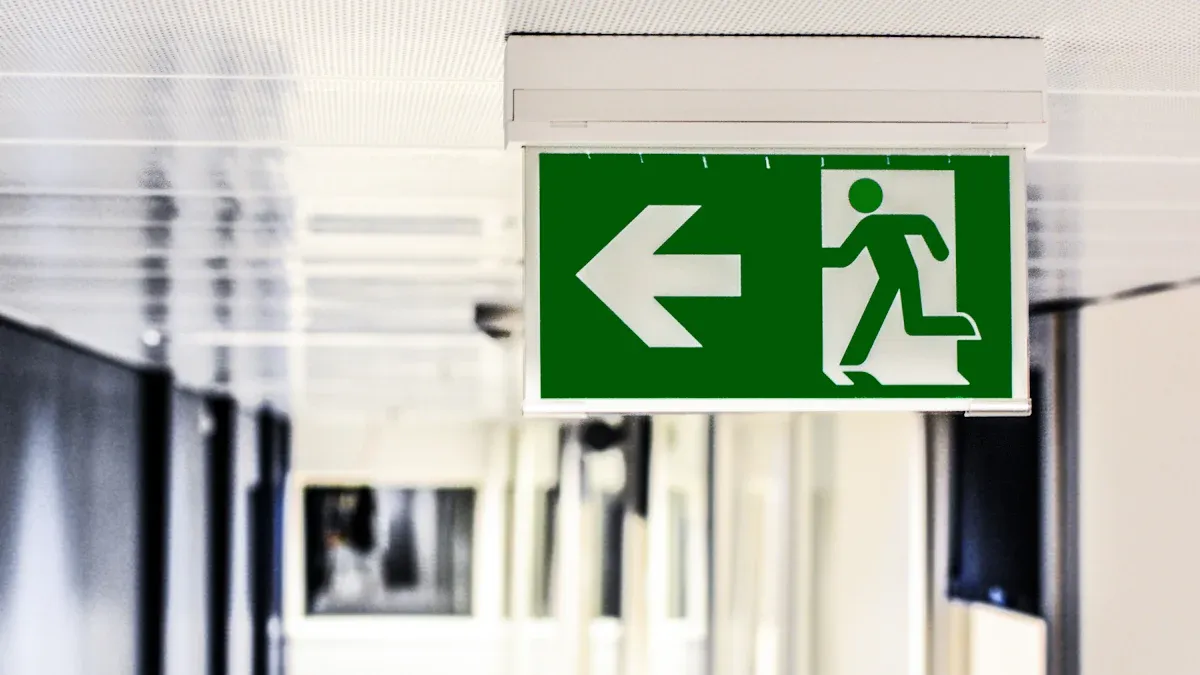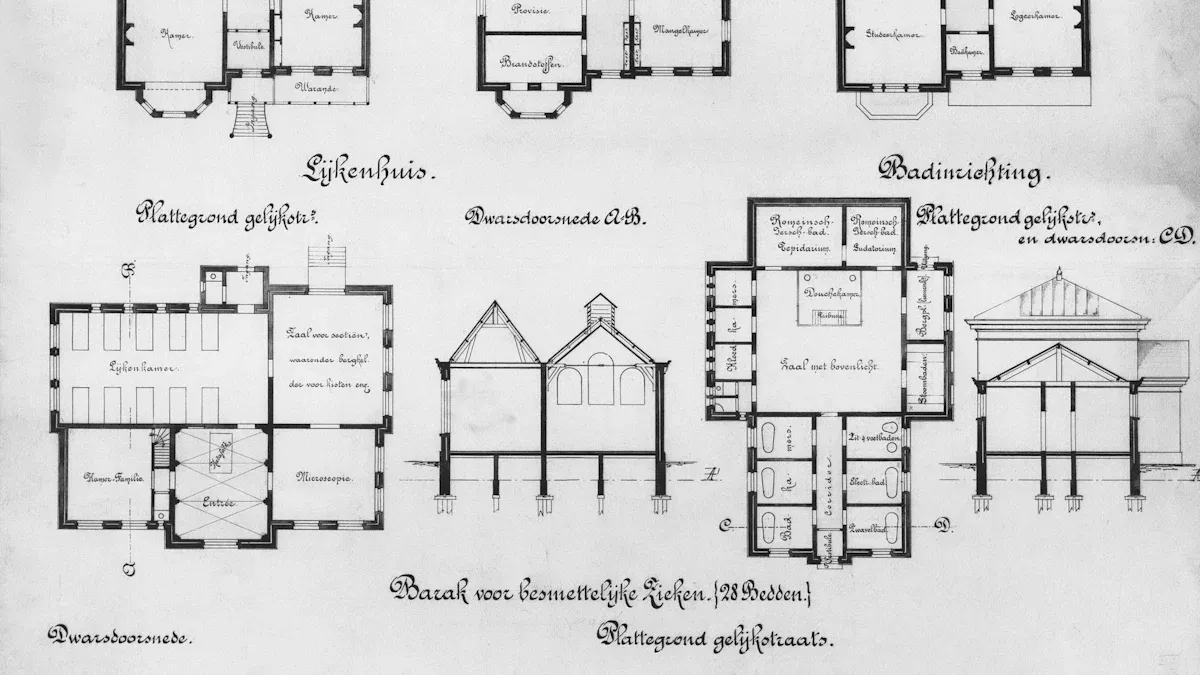Emergency Lighting Plan

You need an emergency lighting plan to keep people safe if the power goes out. This plan tells you how to use emergency lighting to give enough light during an emergency. If you do not have proper emergency lighting, you could get fines or legal problems. Inspectors check if you follow the right rules, so keeping records helps you avoid trouble. Good emergency lighting covers escape routes and gives the right light for at least 90 minutes. Your emergency lighting should work with fire safety systems. Even the best Led Light or Product does not help if you forget these basics. You can find more details on our About Us or Home pages.
Key Takeaways
An emergency lighting plan helps keep people safe. It lights up escape paths when the power goes out or in emergencies. - You must follow laws and rules to put emergency lights in the right spots. Make sure they are bright enough and last long enough. - Pick the best power source, like batteries or generators. This depends on how big your building is and what it needs. - Test your emergency lighting every month and every year. This makes sure it works. Change the batteries when you need to. - Keep exit signs easy to see. Use clear floor plans to help make a good emergency lighting system.
Emergency Lighting Plan Basics

What Is an Emergency Lighting Plan
An emergency lighting plan is your guide for keeping people safe when the lights go out. You use this plan to decide where to put emergency lighting in your building. It shows you how to make sure every hallway, stairwell, and exit stays bright during an emergency. You do not just guess where to put lights. You look at your building and think about where people need to go if something goes wrong. Your emergency lighting plan also tells you how long the lights should stay on and how often you need to check them.
A good emergency lighting plan helps you stay ready for power failures, fires, or other emergencies. You do not want anyone to get lost or panic in the dark. With a clear plan, you know your emergency lighting will work when you need it most.
Why Emergency Lighting Matters
You might wonder why emergency lighting is so important. When an emergency happens, people need to see where they are going. If the power fails, darkness can make it hard to find the exits. Emergency lighting gives you enough light to move safely and quickly. It helps everyone stay calm and avoid accidents.
Emergency lighting and clear exit signs help people find their way out.
Well-lit paths, stairs, and doors guide everyone to safety.
Good lighting lowers panic and helps people leave in an orderly way.
If you do not have emergency lighting, people may waste time trying to plan their escape in the dark. This delay can make evacuation take longer. Emergency lighting helps everyone think clearly and act fast. Older people may need more time to plan, so your emergency lighting plan should work for everyone. You can even train people to practice evacuating under different lighting conditions. This makes your emergency lighting plan even stronger for real emergency situations.
Emergency Lighting Requirements
Code and Legal Standards
You must follow rules when you put in emergency lighting. Many codes and standards tell you what to do. In the United States, you need to know about the International Building Code, National Fire Protection Association standards, and OSHA rules. These rules make sure your emergency lighting works in any emergency.
The International Building Code gives main rules for building systems, including emergency lighting.
NFPA 70, called the National Electrical Code, tells you how to install emergency lighting and emergency power.
NFPA 101, the Life Safety Code, explains how to light up exit paths and what emergency illumination is needed.
OSHA rules say you need at least one foot-candle of light on exit routes.
In healthcare, NFPA 99 adds more rules for standby lighting.
Europe uses rules like BS EN 1838 and BS 5266, which focus on emergency lighting and green exit signs.
You should also look for third-party certifications. UL Certification and ETL Listing show your emergency lighting is safe and works well. In the UK and Europe, BEAB Approval and Nemko are important. These certifications prove your products are safe and reliable.
Tip: Codes and rules can change every few years. You should check for updates and keep your emergency lighting plan up to date.
Placement and Coverage
You cannot put emergency lighting just anywhere. You must follow rules for where to put lights and how much area they cover. Emergency lighting must cover all escape routes, like hallways, stairs, and exits. You also need lights in places where people might trip or fall, like steps or changes in floor level.
Put emergency lighting along every path people might use to leave.
In long hallways, space emergency lights no more than 30 feet apart.
Place emergency lighting at every exit, stairwell, and intersection.
Make sure outdoor exit areas have enough emergency lighting.
In open office spaces, spread out emergency lighting to avoid dark spots. Mount lights 7 to 8 feet high for best coverage.
Always connect emergency lighting to your fire alarm system. This way, the lights turn on right away during an emergency.
You must test your emergency lighting often. Regular checks help you follow all rules and keep your system ready for any emergency.
Illumination and Duration
You must meet rules for how bright emergency lighting is and how long it stays on. The NFPA standards and International Building Code set the lowest light levels for different areas.
Area | Minimum Illumination Level | Reference |
|---|---|---|
General egress paths | NFPA 101, IBC | |
Stairwells during emergency | 10 foot-candles (108 lux) | NFPA 101 Section 7.8.1.3(1) |
Normal operation | 1 foot-candle (10.8 lux) | NFPA 101, IBC |
You must keep these light levels along all exit paths. Your emergency lighting must turn on by itself if the power goes out. The lights must stay on for at least 90 minutes. This gives everyone enough time to leave the building safely. Some places may need longer times, so always check your local rules.
Emergency lighting must give the same amount of light at the start and end of the 90 minutes. The system should switch to emergency power within 10 seconds of a power loss. You can use batteries or generators for emergency power, but the system must work every time.
Note: Connecting your emergency lighting to your fire alarm and life safety system helps everything work together. This setup gives you better control and a faster response during an emergency.
If you follow these rules, you will have a good emergency lighting system. You will keep everyone safe and meet all legal standards.
Emergency Lighting System Design

Choosing Power Sources
When you make your emergency lighting plan, you must choose a power source. You can pick battery-powered systems or generator-powered systems. Each one has good and bad points.
Battery-powered emergency lighting is good for small buildings. It costs less to put in, but you must change batteries every five years. You also need to test these systems every month and once a year. If you do not check them, the lights may not work when needed. Batteries can wear out faster in hot or cold weather, and sometimes they fail half the time.
Generator-powered emergency lighting costs more at first. You need a generator, special switches, and extra wires. These systems are better for big buildings or places with many emergency lighting fixtures. Generators do not need as much testing as batteries, but you still must keep them working well. If the generator stops, all your emergency lights go out at once. Generators also take a few seconds to turn on, which can be a problem if you need light right away.
Some buildings use central inverter systems. These use batteries and turn on with no wait. They are easier to take care of, but you still need to watch for battery problems.
Tip: Battery-powered lights work for small offices or shops. For hospitals, schools, or big stores, a generator or central inverter system may be safer and work better.
Automatic transfer switches (ATS) are important for your emergency lighting system. These switches watch the power all the time. If the main power goes out, the ATS quickly switches to your emergency power. This keeps your emergency lighting on without you doing anything. You must test and check these switches often. If you skip this, the switch may not work, and your emergency lighting could fail in an emergency.
Exit Signs and Luminaires
You need clear exit signs and good emergency lighting fixtures to help people get out safely. There are many types of exit signs and luminaires you can use in your emergency lighting plan. Here are some common types:
Type of Exit Sign | Description | Typical Use/Feature |
|---|---|---|
Recessed Exit Signs | Built into the wall or ceiling for a smooth look, good for fancy or stylish places | Looks simple, protects the sign, saves space |
Single Face Exit Signs | Exit words on one side, put on walls or above doors where you see it from one way | End of hallways, above exit doors |
Double Face Exit Signs | Exit words on both sides, seen from more than one way | Middle of hallways, big open spaces |
NYC Approved Exit Signs | Follow NYC building rules, lit up inside or outside, made from strong materials | Needed in NYC, tough and follows rules |
Exit Sign with Emergency Lights | Exit signs with emergency lighting built in (LED or other) | Helps you see during power outages |
Surface Mount Exit Signs | Put right on the wall or ceiling | Common, easy to use, simple to install |
You can also get edge-lit exit signs, which use LEDs to make the letters glow and look like they float. Swinging exit signs hang from the ceiling and can move if needed. Combo units have exit signs and emergency lights together, which saves space and makes sure both work in an emergency.
Modern LED exit signs use less energy than old ones. LEDs last over ten years and need less fixing. They shine brighter and help people see the way out, even in smoke or darkness. You save money on power and do not have to change bulbs as much.
Note: Always choose exit signs and emergency lighting fixtures that follow your local rules. Look for products with UL or ETL certification for safety and trust.
Layout and Planning Tools
A good emergency lighting plan starts with a strong design. You should use scaled floor plans when you set up your emergency lighting system. These plans show the real size between exits, stairs, and meeting spots. With a scaled plan, you can see where to put each emergency lighting fixture. This helps you avoid dark areas and keeps every path safe.
Scaled floor plans help you keep room sizes and hallway widths right. This means people can find their way faster in an emergency.
You can add “You Are Here” signs in the best spots. This helps people know where they are right away.
Testing your maps with real emergency lighting helps you find problems. You can check if colors and signs are easy to see with only emergency lights on.
For big buildings, digital tools make emergency lighting design easier. Software like AGi32 lets you model your building and test how much light each emergency lighting fixture gives. You can check if your emergency lighting meets the rules before you put anything in. Some systems, like the Emtrons Emcentral Monitoring System, let you control and test all your emergency lighting fixtures from one computer. You get alerts if something fails, and you can keep records for checks.
Pro Tip: Work with a fire safety expert when you plan your emergency lighting system. They can help you pick the best emergency lighting fixtures and make sure your emergency lighting plan follows all safety codes.
Compliance and Maintenance
Regular Testing
You need to test your emergency lighting system often to make sure it works when you need it. Industry standards say you should do both monthly and yearly testing. Monthly testing is quick. You press the test button on each light and check if it turns on. You also look for damage or anything blocking the light. Once a year, you do a full test. You let the lights run for 90 minutes to see if the batteries last and the lights stay bright. This yearly testing checks if your system meets all requirements for backup power and safety.
Testing Interval | Recommended Frequency | Key Tasks Involved |
|---|---|---|
Monthly Testing | Once per month | Visual inspection, test button activation, battery check |
Annual Testing | Once per year | Full system inspection, 90-minute battery test, load testing, update maintenance records |
Tip: Regular testing helps you catch problems early and keeps your emergency lighting ready for any emergency.
Inspections and Recordkeeping
You must keep good records of every inspection and test. After each monthly and yearly test, write down the date, what you checked, and any repairs you made. Keep these records for at least four years. This helps you show inspectors that you follow all requirements. Good recordkeeping also helps you spot patterns, like lights that fail often or batteries that wear out too soon. Many people use inspection software to track everything and set reminders for the next testing.
Write down the date and time of each test.
List which emergency lights you checked and what you found.
Record any repairs or replacements.
Get a signature from the person who did the testing.
Keeping detailed records protects you from fines and helps you stay ready for emergencies.
Upkeep and Battery Replacement
You need to take care of your emergency lighting system to keep it reliable. Batteries are a key part. Most batteries last three to five years, but some can last up to ten years with good care. If a battery fails a 90-minute test, replace it right away. Always use the right type of battery for your system. When you replace a battery, turn off the power, remove the old one, and put in the new one with the same setup. Test the light after you finish. Store spare batteries in a cool, dry place to make them last longer.
Test batteries every month and year.
Replace batteries every three to five years or sooner if they fail a test.
Fix dim or flickering lights quickly to avoid bigger problems.
Remember: Regular testing and upkeep keep your emergency lighting system working and help you meet all safety requirements.
You can make a good emergency lighting plan by doing a few easy things:
Find out the rules and ask local experts for help.
Pick equipment that is certified so it gives safe light.
Put lights in places where people need to see, like exits and stairs.
Check and test your system to make sure the lights work in emergencies.
Change your plan often to follow new rules and make things safer.
Remember: Taking care of your system and planning well helps your lights work when you need them most.
FAQ
How often should you test emergency lighting?
Test your emergency lights once a month. Push the test button to see if they work. Do a full 90-minute test every year. This helps your system stay ready for emergencies.
What happens if you skip emergency lighting maintenance?
If you skip maintenance, your lights may not work in an emergency. You might get fined or fail safety checks. Checking your lights often keeps everyone safe and avoids problems.
Can you install emergency lighting yourself?
You can put in simple emergency lights by following directions. For bigger jobs or large buildings, hire a licensed electrician. This makes sure your system follows all safety rules.
Do LED emergency lights last longer?
LED emergency lights last much longer than old ones. They use less energy and need fewer changes. You save money and get brighter, safer light in emergencies.
See Also
Effective Lighting Solutions For Retail Spaces And Stores
How To Integrate Commercial Electrical Systems For Best Lighting
Commercial Outdoor Lighting Ideas For Safety And Energy Efficiency
Installing Flood Lighting Systems For Homes And Businesses Successfully
Professional Advice On Designing Effective Flood Lighting Setups

